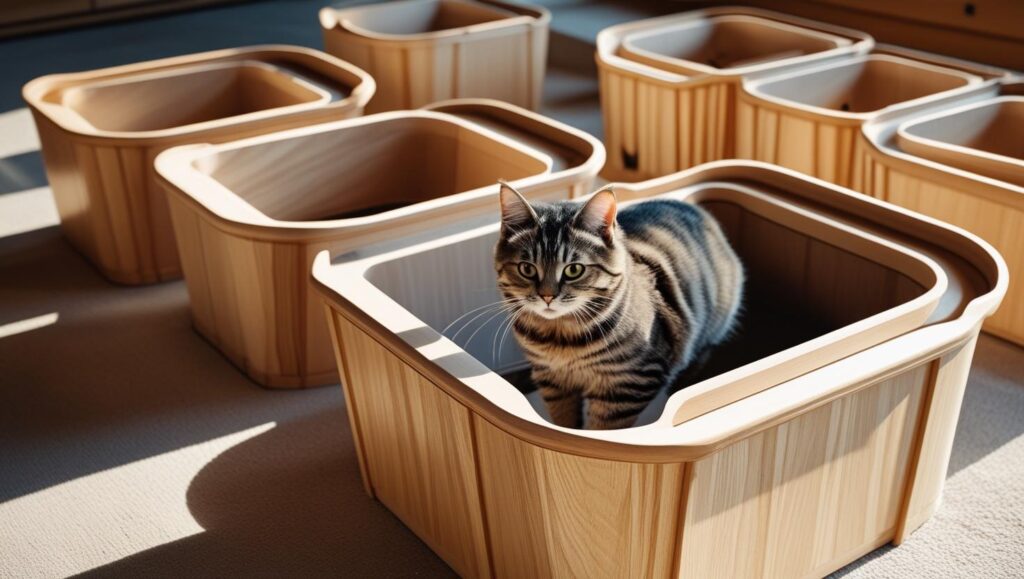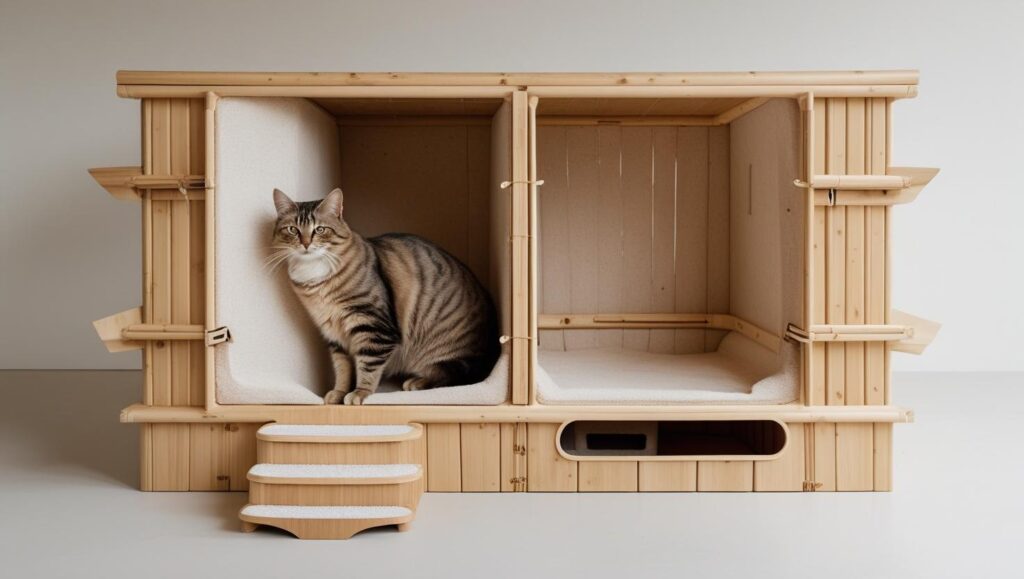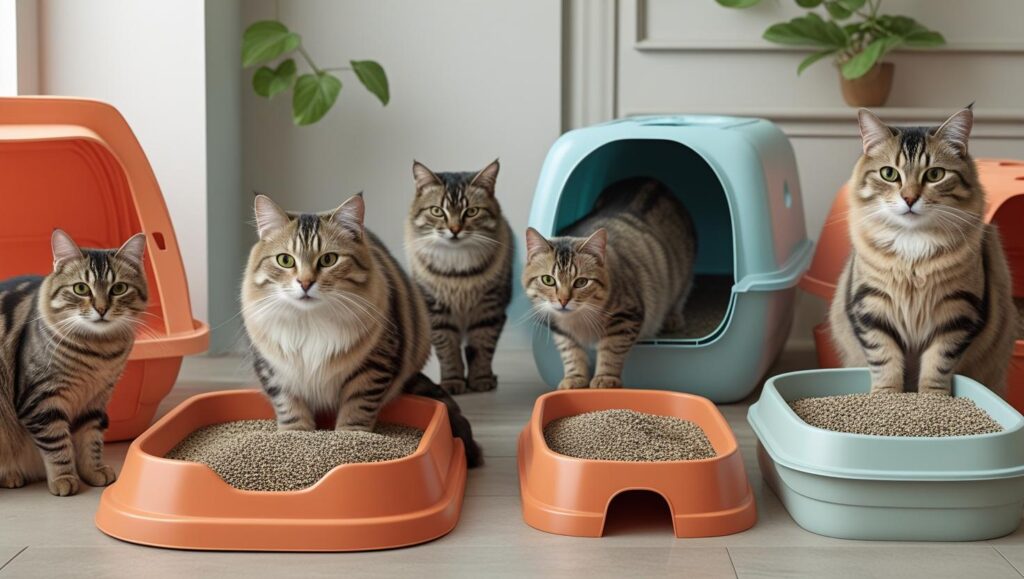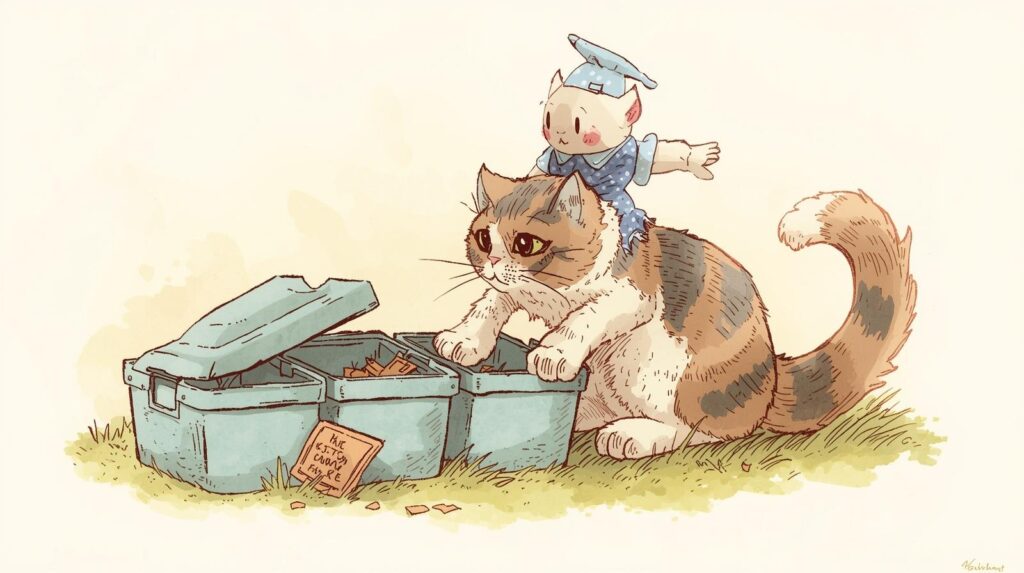Maine Coons are the gentle giants of the cat world — stunning, affectionate, and impressively large. Their lion-like manes, fluffy tails, and playful personalities win hearts everywhere. But along with all that charm comes a reality most owners discover quickly: a regular litter box just doesn’t cut it.
A full-grown Maine Coon can stretch longer than some small dogs, weigh over 20 pounds, and carry a luxurious coat that seems to collect half the litter in the box. Standard pans often leave them cramped, uncomfortable, or makfing them pee outside the box. And when a cat this big isn’t happy with their bathroom setup… you’ll know.

That’s why we created this in-depth guide — built from real owner experiences, breed-specific measurements, hands-on product research, and expert tips. You’ll learn exactly how to measure your Maine Coon for a perfect fit, which litter types keep their fur clean, and the boxes that actually work for their size and habits. Whether you’re setting up for your first Maine Coon kitten or upgrading for a seasoned adult, this guide will help you find a solution that’s comfortable for your cat and easy for you to maintain
1. Our Top Picks for Maine Coon Litter Boxes
Best Overall – iPrimio Stainless Steel XL Litter Pan
Spacious, rust-proof, and nearly indestructible — perfect for handling the size and strength of a Maine Coon while making cleaning effortless.
Best Budget Option – Petmate Giant Litter Pan
Large, durable, and affordable, with high walls to keep litter in and a wide base for stability.
Best Automatic – Litter-Robot 4
A self-cleaning design that can handle the weight and digging style of large cats, saving you time and controlling odors.
Best High-Sided – TownTime High-Sided Extra Large Cat Litter Box
Extra-tall walls prevent litter scatter, even for vigorous diggers, while still offering plenty of floor space.
Best Stainless Steel – Pematar Extra Large XXL
Heavy-duty, odor-resistant, and scratch-proof for years of use — no more embedded smells like plastic boxes.
Best DIY Hack – 50-Gallon Storage Tote Conversion
Cut a side entrance into a large plastic storage bin for a cost-effective, extra-spacious litter box solution.
Best Senior Cat Option – KittyGoHere Extra Large Low-Entry Litter Pan
Gentle on joints with a low entry, yet wide enough for big cats to move comfortably
Table of Contents
2. Why Size & Design Matter for Maine Coon Litter Boxes
Walk into most pet stores and you’ll see shelves stacked with “standard” or even “XL” litter boxes. The problem? Those “extra-large” labels are usually meant for average cats, not for a Maine Coon that can sprawl across your sofa like a small panther.

A box that’s too small forces your cat to squeeze, hunch, or hang halfway out while doing their business. That often leads to messy paws, litter sprayed across your floor, or worse — your cat deciding the box just isn’t worth the effort and stop using it. Once a Maine Coon starts avoiding the litter box, you’re not just dealing with clean-up headaches, you’re also facing potential behavioral issues that can be tough to reverse.
Size and design aren’t just about convenience; they directly affect your cat’s comfort and health. Cramped boxes can make it hard for a Maine Coon to crouch properly, which puts unnecessary strain on their hips and joints — a serious consideration for such a large breed. Poor posture or awkward positioning can also contribute to urinary discomfort, making litter time stressful instead of natural.
A well-sized, well-designed litter box gives your Maine Coon the space to turn, dig, and bury waste comfortably, while keeping the mess contained. It’s not a luxury — it’s a basic need for a cat whose size and habits simply outgrow the “one-size-fits-all” myth.
3. How to Measure Your Maine Coon for the Perfect Litter Box
Choosing a litter box for a Maine Coon isn’t guesswork — it’s math with a bit of common sense. Their size can vary a lot, so the “XL” box that works for one might feel cramped for another. Here’s how to size it just right.
Step 1 — Length Formula
Start with your cat standing naturally. Measure from the tip of the nose to the base of the tail (don’t include the tail itself). Multiply that number by 1.5. That’s your ideal internal length for the box.
Example: If your cat measures 18 inches, 18 × 1.5 = 27 inches.
Step 2 — Width for Comfort
The box’s internal width should be 65–75% of the length you just calculated. This ensures your Maine Coon has enough space to turn, dig, and bury waste without feeling boxed in.
Step 3 — Wall Height Rules
- Open pan: 4–8″ walls (or up to 10–13″ for high-sided models to reduce scatter).
- Senior cats or kittens: low entry around 5–6″ so it’s easy to step in.
- Top-entry models: the entry hole must be wider than your cat’s shoulder width for stress-free access.
Step 4 — The Bare Minimum
For most adult Maine Coons, 28″ long × 20″ wide is the smallest safe starting point. Larger is almost always better.
Pro Tip: A printable “Measure Your Cat” template (with nose-to-tail and shoulder-width markers) can make sizing easy, especially if you’re shopping online
4. Litter Box Types Suitable for Maine Coons
When you have a Maine Coon, “standard” litter boxes often feel like putting a lion in a shoebox — cramped, awkward, and a recipe for mess. These gentle giants need something that matches their size, strength, and personality. Let’s break down the types of litter boxes that actually work for them, with real examples and pros/cons so you can pick the right fit for your furry king (or queen).

4.1 Open Extra-Large Pans
Why it works: The simplest and most budget-friendly option — just a giant open pan with no roof or entry constraints. Maine Coons can stretch, turn, and dig without hitting walls or ducking under a lid.
Best for: Cats who like open space, don’t mind being seen while doing their business, and aren’t serial litter flingers.
Drawbacks: Less odor control, and if your cat digs like they’re mining for gold, you’ll have some cleanup.
Top pick: Petmate Giant Litter Pan (34.7″ L × 19.8″ W × 10″ H) — massive size, deep enough for good litter depth, and has side compartments for scoops or bags.
4.2 High-Sided Boxes
Why it works: Perfect for diggers and “side-scratchers” who like to fling litter halfway across the room. The higher walls help keep everything contained without limiting your cat’s movement.
Best for: Cats with a strong digging habit or messy bathroom style.
Drawbacks: Senior cats or kittens might struggle with very tall sides unless there’s a lowered entry.
Top pick: Frisco High-Sided Litter Box (24″ L × 18″ W × 10″ H) or Smart Paws Jumbo Pan — both big enough for Maine Coons, with an entry cutout.
4.3 Top-Entry Boxes
Why it works: A lid with an entry hole keeps litter inside and dogs/kids out. Great for homes with minimal space or curious toddlers.
Best for: Cats that don’t mind stepping down into the box and have good mobility.
Drawbacks: Not ideal for seniors or cats with arthritis. The hole must be large enough for a Maine Coon’s shoulders (at least 12–13″).
Top pick: Modkat XL (21″ L × 16.5″ W × 17″ H) — large footprint, reversible entry (side or top), and modern design.
4.4 Automatic/Self-Cleaning Boxes
Why it works: You scoop less, your cat enjoys a clean surface every time, and odor control is top-notch.
Best for: Multi-cat homes or owners who want convenience.
Drawbacks: Size is often the biggest problem — many automatic boxes are too cramped for Maine Coons. Always check interior dimensions and weight limits.
Top picks:
- Litter-Robot 4 — accommodates cats up to ~25 lbs, internal space ~20″ diameter.
- Neakasa M1 — one of the largest automatics, with a wide entry and 60 L capacity.
4.5 Heavy-Duty/Stainless Steel Options
Why it works: No odors sticking to plastic, scratch-proof, and built to last for years.
Best for: Owners who are tired of replacing plastic boxes or dealing with lingering smells.
Drawbacks: More expensive, and heavier to move.
Top pick: Custom stainless steel XL pan (at least 28″ L × 20″ W).
4.6 DIY/Storage Tote Hacks
Why it works: Cheap, customizable, and HUGE. A 40–50 gallon Rubbermaid tote can be cut to create an entrance, giving your cat a private, roomy bathroom.
Best for: Budget-conscious owners or cats who need extra floor space.
Drawbacks: Not as stylish, may require more cleaning effort.
Popular hack: Rubbermaid Roughneck 50 Gal (fits even the largest Maine Coons).
4.7 Senior-Friendly Low-Entry Boxes
Why it works: Older Maine Coons with arthritis or hip issues can step in without pain.
Best for: Seniors, recovering cats, or those with mobility issues.
Drawbacks: More litter scatter, since the walls are low.
Top pick: KittyGoHere Senior Pan (24″ L × 20″ W × 5″ entry height).
5. Best Litter Choices for Maine Coons (Especially Long-Haired Cats)
When you live with a Maine Coon, you quickly learn that litter choice isn’t just about odor control — it’s also about keeping their glorious coat clean and your home free from a trail of paw prints. Their long fur, extra tufts between the toes, and larger paws can turn the wrong litter into a tracking nightmare.
Here’s what our research, plus input from dozens of Maine Coon owners, says about your main options:
Clay Clumping Litter
- Pros: Widely available, strong odor control, and easy scooping.
- Cons: Can stick to toe fur, heavier tracking, and some brands are dusty.
- Best for: Owners who scoop daily and don’t mind sweeping around the box.
Crystal (Silica) Litter
- Pros: Low dust, lightweight, and less likely to cling to fur. Great for reducing smell in multi-cat homes.
- Cons: Some cats dislike the texture, needs occasional stirring to prevent moisture build-up.
- Best for: Long-haired cats prone to clay sticking.
Pellet Litter (Wood or Paper)
- Pros: Minimal tracking, biodegradable, and gentle on fur. Wood pellets offer natural odor control.
- Cons: Larger pellets may be less comfortable for some cats, and urine separation can require extra cleaning effort.
- Best for: Cats with sensitive paws or owners who want an eco-friendly choice.
Owner Insights: Many Maine Coon parents swear by mixing litter types — for example, a base of pellets topped with a thin layer of clay or crystal — to balance comfort, odor control, and low tracking.
6. Real Owner Insights: What Maine Coon Owners Say Works
Talk to enough Maine Coon owners, and a few themes come up again and again. These cats aren’t just bigger — their litter box needs are too. Here’s what the community says actually works in day-to-day life:
1. Size matters more than the label “XL.”
Many owners said the term XL on a box doesn’t always mean it’s big enough. “If my cat can’t turn around without touching the sides, it’s too small,” one Reddit user noted. Some even use under-bed storage totes or large storage bins with a DIY entrance cutout instead of commercial boxes.
2. Litter choice can make or break your cleaning routine.
Long fur + fine clay litter = a mess. Several owners switched to crystal or pellet litter and reported less tracking and fewer clumps sticking to tail or paw fur. One Facebook group member summed it up: “It’s not just about smell control — it’s about keeping it out of their pants!”
3. Stainless steel boxes are a quiet game-changer.
Plastic boxes can absorb odor over time, especially when used by a big, heavy cat. Multiple owners praised stainless steel boxes for staying clean-smelling and lasting for years. A few handy owners even built custom wooden frames to hold them in place and match home décor.
4. Creative solutions solve big problems.
From cutting a doorway into a closet to hide the box, to using a boot tray under the litter box for stray litter, owners get inventive. A Reddit user shared: “I put a thin layer of wood pellets under my regular clumping litter — it stopped the paw snowshoes.”
5. Matching the litter to the box type matters.
A covered box can trap odors if paired with clay litter, but works beautifully with silica crystals. Open boxes pair well with clumping clay if scooped often. The best combos come from a bit of trial and error.
7. Special Considerations for Maine Coons
7.1 Multi-Cat Households
Maine Coons already need more litter space than the average cat, so when you add multiple cats to the mix, you can’t rely on the “one box per cat” rule alone. For large breeds, it’s smarter to add an extra beyond the standard formula (cats + 1).
- Box size: Stick to at least 28″ L × 20″ W for each box so the Maine Coons have full turning and digging room without feeling cramped.
- Placement: Spread boxes across different rooms or floors to reduce competition.
- Type choice: In multi-cat homes, open or high-sided pans are preferred over enclosed boxes for easier access and better odor control.
Tip from owners: Two extra-large boxes in opposite corners of the house can stop “territory guarding” behaviors.
7.2 Senior / Arthritic Cats
Older Maine Coons, especially those with arthritis or hip issues, need low-entry boxes to keep bathroom trips pain-free.
- Entry height: Aim for 5–6 inches at the lowest point, even if the back/sides are higher to prevent scatter.
- Placement: Put the box on the same floor where your cat spends most of their time — avoid stairs.
- Surface comfort: Use a non-slip mat outside the box to help with stability when entering or exiting.
Best pick: KittyGoHere Senior Pan or modified storage tote with a cut-down entrance.
7.3 Small Home / Apartment Placement
Finding space for a Maine Coon-sized litter box in a compact home can be tricky — but it’s doable with some creativity.
- Furniture integration: Hide an XXL box inside an IKEA cabinet or storage bench with a cut-out entrance.
- Vertical use: Raise the box on a sturdy platform to free up floor space underneath for storage.
- Corners & dead space: Place high-sided or top-entry boxes in unused corners, laundry rooms, or behind screens.
- Odor control: For close living quarters, pair the box with low-dust, low-odor litter and a small air purifier nearby.
Pro tip: In small spaces, measure your available footprint before buying — Maine Coon boxes can easily exceed 3 feet in length.
8. Litter Box Testing for Maine Coons: What Really Holds Up
8.1 Box Dimension Comparisons
We tested popular “XL” litter boxes to see if they truly fit a Maine Coon’s size needs.
- Petmate Giant Pan – 26″ × 18″ inside dimensions: good length, borderline width.
- Frisco High-Sided XL – 28″ × 20″: meets comfort guidelines for most adults.
- DIY 50-gallon tote – 32″ × 21″: extra space for stretching, turning, and digging.
Verdict: Anything under 28″ long often feels cramped for a 20 lb cat.
8.2 Stability & Load Testing for Big Cats (20+ lbs)
We checked whether boxes wobble, flex, or tip when a Maine Coon jumps in:
- Thin plastic pans: noticeable flex; prone to cracking after heavy use.
- Heavy-duty plastic: stable if base is wide and weight is evenly distributed.
- Stainless steel pans: zero flex, rock-solid stability.
Tip: Look for anti-slip feet or place on a non-skid mat.
8.3 Litter Tracking & Fur Adhesion Tests
We compared litter types for how much stuck to fur and got tracked out:
- Clay clumping – highest tracking; dust can cling to belly fur.
- Crystal (silica) – minimal sticking; larger granules reduce fur mess.
- Wood pellets – very low tracking but heavier box cleaning due to pellet breakdown.
Winner for long-haired cats: Crystal or large-grain natural litters.
8.4 Durability: Scratch & Crack Resistance
We simulated a year of heavy scratching:
- Budget plastic – scratches deep within weeks, harboring odor.
- Premium plastic – better resistance, but may crack in extreme cold.
- Stainless steel – virtually scratch-proof, no odor retention.
Bottom line: Big cats = big claws; invest in tougher materials for longevity.
9. Quick Decision Flowchart: Which Litter Box Should You Buy?
Start Here →
- Is your cat indoor-only?
- Yes → Go bigger than you think.
- Multi-cat household? → Stainless Steel XL Pan (Frisco, iPrimio) for easy deep cleans.
- Single cat? → Frisco High-Sided XL for mess control.
- No (indoor-outdoor) → Mid-size high-sided box or top-entry box to contain dirt.
- Yes → Go bigger than you think.
- Do you have multiple cats?
- Yes → At least 1 box per cat + 1 extra. Choose open, high-walled models for airflow.
- No → You can go with covered or top-entry if odor isn’t a big issue.
- Is your cat a senior or mobility-limited?
- Yes → Low-entry stainless steel or large plastic pan (Petmate Giant). Avoid top-entry.
- No → Any entry height is fine; focus on space.
- Are you on a strict budget?
- Yes → DIY 50-gallon storage tote with cut-out entry (cost under $20).
- No → Stainless steel or premium plastic for long-term durability.
- Is your cat an aggressive digger?
- Yes → Deep, high-sided box (≥10 inches walls) + heavier litter (crystal or pellets).
- No → Standard high-sided box is fine.
FAQ – Maine Coon Litter Box Questions Answered
Q1: What size litter box does a Maine Coon need?
A Maine Coon needs an extra-large litter box at least 22–24 inches long and 15–18 inches wide so they can turn, dig, and cover waste comfortably. Bigger is always better for these gentle giants.
Q2: Can a Maine Coon use a covered litter box?
Yes — but choose a jumbo covered litter box with a high roof clearance to avoid restricting movement. Some Maine Coons prefer open designs for better ventilation and easier access.
Q3: What’s the best litter for Maine Coons with long fur?
The best litter is low-dust, non-clumping crystal litter or large-grain natural pellets since they are less likely to stick to fur and paws compared to fine clay litter.
Q4: How many litter boxes should you have for a Maine Coon?
The golden rule is one litter box per cat plus one extra. For a single Maine Coon, two boxes are ideal — especially in multi-level homes.
Q5: How do I stop my Maine Coon from tracking litter everywhere?
Use low-tracking litter, a high-sided litter box, and a large litter mat outside the entrance. You can also try a top-entry design for better litter containment.
Q6: Is an automatic litter box worth it for Maine Coons?
Yes — models like the Litter-Robot 4 or Catlink Pro handle larger waste clumps and heavier cats, saving cleaning time and keeping odors in check. Just ensure the entrance and interior size are big enough.
Conclusion
When it comes to Maine Coons, comfort and health start with the right litter box size and litter type. A spacious, sturdy box combined with low-tracking, fur-friendly litter can make all the difference in cleanliness, odor control, and your cat’s overall happiness.
Before you buy, measure your Maine Coon from nose to tail and compare it to the interior dimensions of the box. This ensures they have enough room to turn, dig, and cover waste without feeling cramped.


